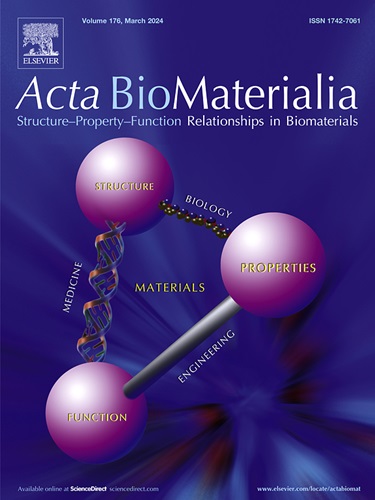基于可聚合离子液体的抗炎和抗菌水凝胶。
IF 9.4
1区 医学
Q1 ENGINEERING, BIOMEDICAL
引用次数: 0
摘要
在当今时代,皮肤感染伤口及其相关炎症的治疗构成了一个重大挑战。这些感染有可能阻碍愈合过程,并成为危及生命的病理,特别是由于细菌耐药性的增加。由于水凝胶具有独特的性能和多功能性,因此可以成功解决这一问题。其中,天然聚合物基水凝胶因其类似于细胞外基质(ECM)和天然组织的力学性能而具有特别的优势。在本研究中,我们提出了一种由甲基丙烯酸明胶为基质和水杨酸盐(Sal)阴离子交换可聚合离子液体(PIL)组成的双作用水凝胶,以实现抗炎和抗菌活性。该材料促进细胞附着和定植小鼠内皮成纤维细胞。通过流式细胞术评估其抗炎作用,并证实小鼠巨噬细胞向M2(修复)表型分化。因此,我们量化了TNF-α、白细胞介素-6 (IL-6)和白细胞介素(IL-10)的水平来进一步评估这种作用,结果显示对促炎因子有抑制作用。对金黄色葡萄球菌和大肠杆菌固有的抗菌能力被证明,从而证实了它作为伤口敷料的潜力。据我们所知,这是第一个报道的含有阴离子交换可聚合离子液体的水凝胶,它能够促进巨噬细胞分化为修复型,减少促炎细胞因子,同时保持抗菌活性。这些特点为这种水凝胶作为伤口敷料的潜在应用打开了大门。重要意义:细菌性伤口感染可能导致严重的问题,由于其相关的组织炎症和细菌耐药性的出现。从这个意义上说,局部疗法,如水凝胶已经聚集了很多关注作为替代治疗这些病理。在这项工作中,我们开发了一种天然聚合物基水凝胶,它与含有水杨酸作为阴离子的可聚合离子液体共聚。水凝胶被证明具有生物相容性,并促进巨噬细胞分化为修复表型,同时降低促炎细胞因子的水平。最后,对革兰氏阳性和革兰氏阴性细菌的高抗菌能力使其成为伤口敷料的有希望的候选者。本文章由计算机程序翻译,如有差异,请以英文原文为准。

Anti-inflammatory and antibacterial hydrogel based on a polymerizable ionic liquid
In the present era, the treatment of skin-infected wounds and their associated inflammation constitutes a significant challenge. These infections have the potential to impede the healing process and become a life-threatening pathology, particularly due to the rise of bacterial resistance. Hydrogels could successfully address this issue due to their unique capabilities and versatility. Among them, natural polymer-based hydrogels are especially advantageous as they resemble the extracellular matrix (ECM) and mechanical properties of natural tissues. In this study, we propose a dual-action hydrogel composed of methacrylated gelatin as a matrix and a salicylate (Sal) anion-exchanged polymerizable ionic liquid (PIL) to achieve anti-inflammatory and antibacterial activities. This material facilitated cell attachment and colonization with mouse endothelial fibroblasts. A flow cytometry assay was conducted to evaluate the anti-inflammatory effect, and demonstrated the differentiation of mouse macrophages to an M2 (reparative) phenotype. Therefore, the levels of TNF-α, interleukin-6 (IL-6), and interleukin (IL-10) were quantified to further evaluate this effect, demonstrating an inhibition on the pro-inflammatory ones. The inherent antibacterial capacity of the PIL was demonstrated against Staphylococcus aureus and Escherichia coli, thereby corroborating its potential as a wound dressing. To the best of our knowledge, this is the first reported hydrogel incorporating an anion-exchanged polymerizable ionic liquid that is capable of promoting macrophage differentiation into a reparative phenotype, of reducing pro-inflammatory cytokines, and of simultaneously retaining antibacterial activity. These features open the gate to the potential application of this hydrogel as a wound dressing.
Statement of significance
Bacterial wound infections may lead to severe problems due to their associate tissue inflammation and the emergence of bacterial resistance. In this sense, local therapies such as hydrogels have gathered much attention as alternative therapies for these pathologies. In this work, we have developed a natural polymer-based hydrogel copolymerized with a polymerizable ionic liquid containing salicylate as an anion. The hydrogel was shown to be biocompatible, and promoted macrophage differentiation to a reparative phenotype, while reducing the levels of pro-inflammatory cytokines. Finally, the high antibacterial capability against both gram-positive and gram-negative bacteria makes it a promising candidate for use in wound dressings.
求助全文
通过发布文献求助,成功后即可免费获取论文全文。
去求助
来源期刊

Acta Biomaterialia
工程技术-材料科学:生物材料
CiteScore
16.80
自引率
3.10%
发文量
776
审稿时长
30 days
期刊介绍:
Acta Biomaterialia is a monthly peer-reviewed scientific journal published by Elsevier. The journal was established in January 2005. The editor-in-chief is W.R. Wagner (University of Pittsburgh). The journal covers research in biomaterials science, including the interrelationship of biomaterial structure and function from macroscale to nanoscale. Topical coverage includes biomedical and biocompatible materials.
 求助内容:
求助内容: 应助结果提醒方式:
应助结果提醒方式:


